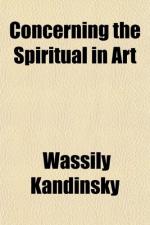Without such development as this, form-composition is impossible. To anyone who cannot experience the inner appeal of form (whether material or abstract) such composition can never be other than meaningless. Apparently aimless alterations in form-arrangement will make art seem merely a game. So once more we are faced with the same principle, which is to set art free, the principle of the inner need.
When features or limbs for artistic reasons are changed or distorted, men reject the artistic problem and fall back on the secondary question of anatomy. But, on our argument, this secondary consideration does not appear, only the real, artistic question remaining. These apparently irresponsible, but really well-reasoned alterations in form provide one of the storehouses of artistic possibilities.
The adaptability of forms, their organic but inward variations, their motion in the picture, their inclination to material or abstract, their mutual relations, either individually or as parts of a whole; further, the concord or discord of the various elements of a picture, the handling of groups, the combinations of veiled and openly expressed appeals, the use of rhythmical or unrhythmical, of geometrical or non-geometrical forms, their contiguity or separation—all these things are the material for counterpoint in painting.
But so long as colour is excluded, such counterpoint is confined to black and white. Colour provides a whole wealth of possibilities of her own, and when combined with form, yet a further series of possibilities. And all these will be expressions of the inner need.
The inner need is built up of three mystical elements: (1) Every artist, as a creator, has something in him which calls for expression (this is the element of personality). (2) Every artist, as child of his age, is impelled to express the spirit of his age (this is the element of style)—dictated by the period and particular country to which the artist belongs (it is doubtful how long the latter distinction will continue to exist). (3) Every artist, as a servant of art, has to help the cause of art (this is the element of pure artistry, which is constant in all ages and among all nationalities).
A full understanding of the first two elements is necessary for a realization of the third. But he who has this realization will recognize that a rudely carved Indian column is an expression of the same spirit as actuates any real work of art of today.




